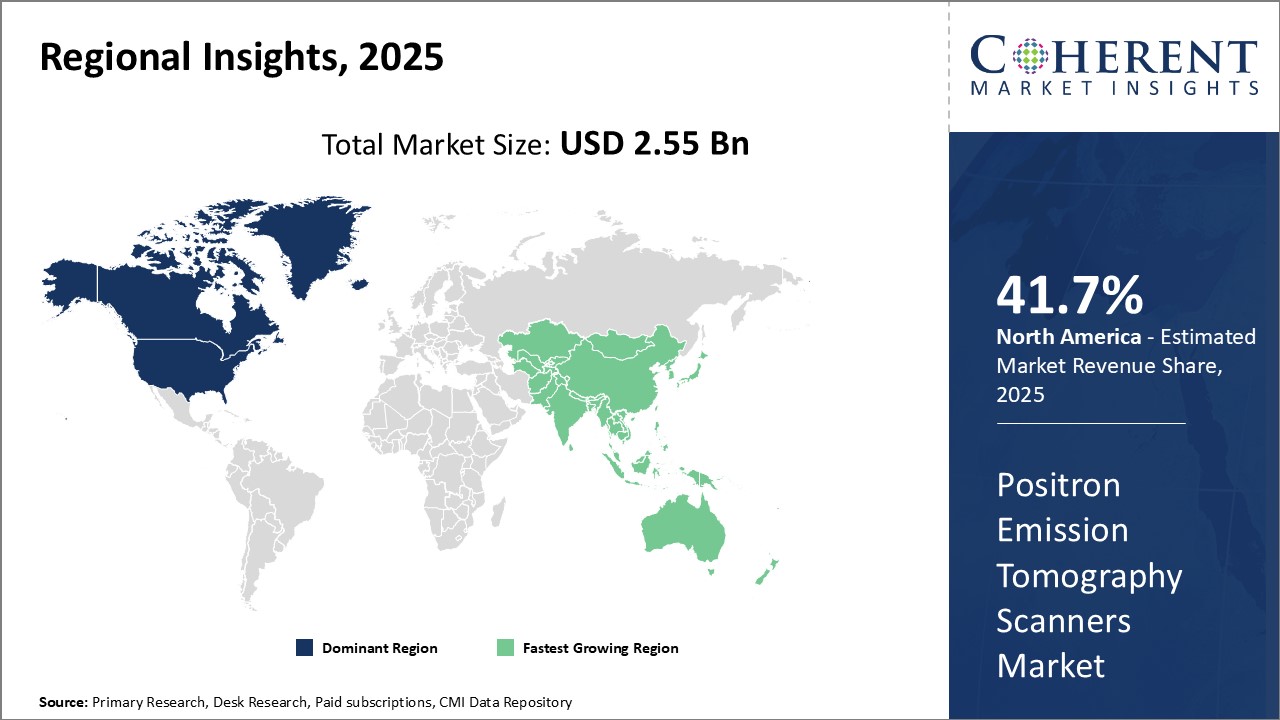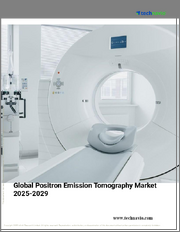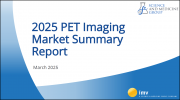
|
시장보고서
상품코드
1672697
양전자방출단층촬영(PET) 스캐너 시장 : 제품 유형별, 용도별, 검출기 유형별, 최종 사용자별, 지역별Positron Emission Tomography (PET) Scanners Market, By Product Type, By Application, By Detector Type, By End User, By Geography |
||||||
세계의 양전자방출단층촬영(PET) 스캐너 시장은 2025년 25억 5,000만 달러를 기록할 것으로 추정됩니다. 2032년에는 37억 9,000만 달러에 달할 것으로 예측되며, 2025-2032년에 걸쳐 CAGR은 5.8%를 나타낼 것으로 예상됩니다.
| 보고 범위 | 보고서 세부정보 | ||
|---|---|---|---|
| 기준 연도 | 2024년 | 2025년 시장 규모 | 25억 5,000만 달러 |
| 실적 데이터 | 2020-2024년 | 예측 기간 | 2025-2032년 |
| 예측 기간(2025-2032년) CAGR | 5.80% | 2032년 금액 예측 | 37억 9,000만 달러 |

양전자방출단층촬영(PET)은 신체의 기능적 과정의 3차원 영상을 생성하는 핵의료 기능 영상 기술입니다. PET 스캐너는 대개 조영술 CT와 MRI 이미지에 의한 침습적 치료의 보조 또는 대안으로 신체의 대사 과정을 관찰하는 데 사용됩니다. PET 검사는 종종 암이나 심혈관계 질환을 검출·진단하고, 질병의 단계를 평가하고, 암 종양의 치료 효과를 보기 위해서 이용됩니다. PET 영상 진단의 상당한 기술 발전으로 해상도와 감도가 향상되었으며 종양, 전이 및 기타 이상 검출 및 특성화가 개선되었습니다. 감도가 높고 암의 병기 분류 및 재병기 분류에 유용한 등의 이점은 시장 성장을 가속시킬 수 있습니다.
시장 역학 :
세계의 양전자방출단층촬영(PET) 스캐너 시장 성장의 원동력은 암과 심장 질환과 같은 만성 질환의 세계 유병률의 상승입니다. 암은 주요 사망 원인 중 하나이며 조기 정확한 진단과 병기 분류가 매우 중요합니다. PET 이미지는 기능적인 정보를 제공하며 암의 조기 발견에 도움이 됩니다. 또한, 해상도 향상과 스캔 시간 단축을 가능하게 하는 하이브리드 스캐너를 가능하게 하는 기술의 진보는 시장 성장을 가속합니다. 그러나 높은 설비 비용과 숙련된 전문가의 부족은 시장 성장을 방해할 수 있습니다. 또한 새로운 시스템에 대한 제한된 상환금 및 규제 장애물도 시장 성장을 방해할 수 있습니다. 의료 투자가 확대되고 있는 신흥국에는 성장 기회가 있습니다.
본 조사의 주요 특징
본 보고서에서는 세계의 양전자방출단층촬영(PET) 스캐너 시장을 상세하게 분석하여 2024년을 기준연도로 한 예측기간(2025-2032년) 시장 규모(10억 달러)와 복합연간 성장률(CAGR%)을 제공합니다.
또한 다양한 부문에서 잠재적인 수익 기회를 밝히고 이 시장의 매력적인 투자 제안 매트릭스를 설명합니다.
또한 시장 성장 촉진요인, 억제요인, 기회, 신제품의 출시 및 승인, 시장 동향, 지역에 의한 전망, 주요 기업이 채용하는 경쟁 전략 등에 관한 주요 인사이트도 제공합니다.
본 조사의 대상이 되는 주요 기업으로는 Koninklijke Philips, United Imaging Healthcare, Siemens Healthineers, Canon Inc., Hologic, Inc. 등이 있습니다.
이 보고서의 인사이트를 통해 마케팅 담당자와 기업 경영진은 향후 제품 출시, 타이핑, 시장 확대, 마케팅 전술에 대한 정보를 바탕으로 의사 결정을 내릴 수 있습니다.
세계의 양전자방출단층촬영(PET) 스캐너 시장 보고서는 투자자, 공급업체, 제품 제조업체, 유통업체, 신규 참가자, 재무 분석가 등 이 산업의 다양한 이해관계자를 지원합니다.
이해관계자들은 세계의 양전자방출단층촬영(PET) 스캐너 시장 분석에 사용되는 다양한 전략 매트릭스를 통해 의사결정을 용이하게 할 수 있습니다.
목차
제1장 조사의 목적과 전제조건
- 조사 목적
- 전제조건
- 약어
제2장 시장 전망
- 보고서 설명
- 시장 정의와 범위
- 주요 요약
- Coherent Opportunity Map (COM)
제3장 시장 역학, 규제, 동향 분석
- 시장 역학
- 성장 촉진요인
- 성장 억제요인
- 기회
- 영향 분석
- 시장 동향
- 규제 시나리오
- 인수와 제휴 시나리오
- 자금 조달 및 투자
- PEST 분석
- Porter's Five Forces 분석
제4장 세계의 양전자방출단층촬영(PET) 스캐너 시장 - 코로나바이러스(COVID-19) 유행의 영향
- 전체적인 영향
- 정부의 대처
- COVID-19에 의한 시장에 대한 영향
제5장 세계의 양전자방출단층촬영(PET) 스캐너 시장, 제품 유형별(2020-2032년), 10억 달러
- 서론
- 풀 링 PET 스캐너
- 부분 링 PET 스캐너
제6장 세계의 양전자방출단층촬영(PET) 스캐너 시장, 용도별(2020-2032년), 10억 달러
- 서론
- 종양학
- 심장학
- 신경학
- 기타
제7장 세계의 양전자방출단층촬영(PET) 스캐너 시장, 검출기 유형별(2020-2032년), 10억 달러
- 서론
- 비스무트 게르마늄 산화물(BGO)
- 루테튬 옥시오르토실리케이트(LSO)
- 가돌리늄 옥시오르토실리케이트(GSO)
- 루테튬 미세규산염(LFS)
- 루테튬 이트륨 오르토실리케이트
제8장 세계의 양전자방출단층촬영(PET) 스캐너 시장, 최종 사용자별(2020-2032년), 10억 달러
- 서론
- 병원
- 영상진단센터
- 학술 alc 연구기관
- 기타
제9장 세계의 양전자방출단층촬영(PET) 스캐너 시장, 지역별(2020-2032년), 10억 달러
- 서론
- 북미
- 라틴아메리카
- 유럽
- 아시아태평양
- 인도
- 일본
- ASEAN 국가
- 호주
- 한국
- 기타 아시아태평양
- 중동
- GCC 국가
- 이스라엘
- 기타 중동
- 아프리카
- 북아프리카
- 중앙아프리카
- 남아프리카
제10장 경쟁 구도
- 기업 프로파일
- Siemens Healthineers AG
- General Electric Company(GE Healthcare)
- Koninklijke Philips NV
- Canon Medical Systems Corporation
- United Imaging Healthcare Co., Ltd.
- Toshiba Medical Systems Corporation
- Hitachi, Ltd.
- Neusoft Medical Systems Co., Ltd.
- Shimadzu Corporation
- Mediso Ltd.
- MR Solutions
- TriFoil Imaging
- Cubresa Inc.
- Spectrum Dynamics Medical
- Radiology Support Devices, Inc.
- Modus Medical Devices Inc.
- Curvebeam LLC
- Planmeca Oy
제11장 애널리스트 추천
- 융성과 쇠퇴
- 일관형 기회 맵
제12장 참고문헌과 조사방법
- 참고문헌
- 조사방법
Global Positron Emission Tomography Scanners Market is estimated to be valued at USD 2.55 Bn in 2025 and is expected to reach USD 3.79 Bn by 2032, growing at a compound annual growth rate (CAGR) of 5.8% from 2025 to 2032.
| Report Coverage | Report Details | ||
|---|---|---|---|
| Base Year: | 2024 | Market Size in 2025: | USD 2.55 Bn |
| Historical Data for: | 2020 To 2024 | Forecast Period: | 2025 To 2032 |
| Forecast Period 2025 to 2032 CAGR: | 5.80% | 2032 Value Projection: | USD 3.79 Bn |

Positron emission tomography (PET) is a nuclear medicine functional imaging technique that produces three-dimensional images of functional processes in the body. PET scanners are typically used to observe the metabolic processes in the body as an aid or alternative to invasive procedures with contrast-enhanced CT or MRI imaging. PET scans are often used to detect and diagnose cancer or cardiovascular disease, assess the stage of disease, and see how well cancer tumors respond to treatment. Significant technological advancements in PET imaging have allowed for improved resolution and sensitivity, enabling improved detection and characterization of tumours, metastases, and other abnormalities. Advantages such as high sensitivity and utility in staging and restaging of cancer can drive the market growth.
Market Dynamics:
Global positron emission tomography (PET) scanners market growth is driven by rising prevalence of chronic diseases such as cancer and cardiac disorders worldwide. Cancer being one of the leading causes of mortality, early accurate diagnosis and staging is crucial. PET imaging provides functional information and helps detect cancer in early stages. Moreover, technological advancements enabling hybrid scanners with improved resolution and shorter scanning times can drive the market growth. However, high equipment costs and scarcity of skilled professionals can hamper the market growth. Limited reimbursements and regulatory hurdles for new systems can also hamper the market growth. Emerging economies with growing healthcare investments can offer growth opportunities.
Key Features of the Study:
This report provides in-depth analysis of the global positron emission tomography (PET) scanners market, and provides market size (USD Billion) and compound annual growth rate (CAGR%) for the forecast period (2025-2032), considering 2024 as the base year
It elucidates potential revenue opportunities across different segments and explains attractive investment proposition matrices for this market
This study also provides key insights about market drivers, restraints, opportunities, new product launches or approval, market trends, regional outlook, and competitive strategies adopted by key players
Key companies covered as a part of this study include Koninklijke Philips, United Imaging Healthcare, Siemens Healthineers, Canon Inc., and Hologic, Inc.
Insights from this report would allow marketers and the management authorities of the companies to make informed decisions regarding their future product launches, type up-gradation, market expansion, and marketing tactics
Global positron emission tomography (PET) scanners market report caters to various stakeholders in this industry including investors, suppliers, product manufacturers, distributors, new entrants, and financial analysts
Stakeholders would have ease in decision-making through various strategy matrices used in analyzing the global positron emission tomography (PET) scanners market
Detailed Segmentation-
- By Product Type
- Full Ring PET Scanner
- Partial Ring PET Scanner
- By Application
- Oncology
- Cardiology
- Neurology
- By Detector Type
- Bismuth Germanium Oxide (BGO)
- Lutetium Oxyorthosilicate (LSO)
- Gadolinium Oxyorthosilicate (GSO)
- Lutetium Fine Silicate (LFS)
- Lutetium Yttrium Orthosilicate
- By End User
- Hospitals
- Diagnostic Imaging Centers
- Academic & Research Institutes
- Others
- By Region
- North America
- Europe
- Asia Pacific
- Latin America
- Middle East
- Africa
- Company Profiles:
- Siemens Healthineers AG
- General Electric Company (GE Healthcare)
- Koninklijke Philips N.V.
- Canon Medical Systems Corporation
- United Imaging Healthcare Co., Ltd.
- Toshiba Medical Systems Corporation
- Hitachi, Ltd.
- Neusoft Medical Systems Co., Ltd.
- Shimadzu Corporation
- Mediso Ltd.
- MR Solutions
- TriFoil Imaging
- Cubresa Inc.
- Spectrum Dynamics Medical
- Radiology Support Devices, Inc.
- Modus Medical Devices Inc.
- Curvebeam LLC
- Planmeca Oy
Table of Contents
1. Research Objectives and Assumptions
- Research Objectives
- Assumptions
- Abbreviations
2. Market Purview
- Report Description
- Market Definition and Scope
- Executive Summary
- Market Snapshot, By Product Type
- Market Snapshot, By Application
- Market Snapshot, By Detector Type
- Market Snapshot, By End User
- Market Snapshot, By Region
- Coherent Opportunity Map (COM)
3. Market Dynamics, Regulations, and Trends Analysis
- Market Dynamics
- Drivers
- Restraints
- Opportunities
- Impact Analysis
- Market Trends
- Key Developments
- Regulatory Scenario
- Acquisitions and Partnerships Scenario
- Funding and Investments
- PEST Analysis
- Porter's Analysis
4. Global Positron Emission Tomography (PET) Scanners Market- Impact of Coronavirus (COVID-19) Pandemic
- Overall Impact
- Government Initiatives
- COVID-19 Impact on the Market
5. Global Positron Emission Tomography (PET) Scanners Market, By Product Type, 2020 - 2032, (USD Bn)
- Overview
- Market Share Analysis, 2025 and 2032 (%)
- Y-o-Y Growth Analysis, 2020 - 2032
- Segment Trends
- Full Ring PET Scanner
- Overview
- Market Size and Forecast, and Y-o-Y Growth, 2020-2032, (USD Bn)
- Partial Ring PET Scanner
- Overview
- Market Size and Forecast, and Y-o-Y Growth, 2020-2032, (USD Bn)
6. Global Positron Emission Tomography (PET) Scanners Market, By Application, 2020 - 2032, (USD Bn)
- Overview
- Market Share Analysis, 2025 and 2032 (%)
- Y-o-Y Growth Analysis, 2020 - 2032
- Segment Trends
- Oncology
- Overview
- Market Size and Forecast, and Y-o-Y Growth, 2020-2032, (USD Bn)
- Cardiology
- Overview
- Market Size and Forecast, and Y-o-Y Growth, 2020-2032, (USD Bn)
- Neurology
- Overview
- Market Size and Forecast, and Y-o-Y Growth, 2020-2032, (USD Bn)
- Others
- Overview
- Market Size and Forecast, and Y-o-Y Growth, 2020-2032, (USD Bn)
7. Global Positron Emission Tomography (PET) Scanners Market, By Detector Type, 2020 - 2032, (USD Bn)
- Overview
- Market Share Analysis, 2025 and 2032 (%)
- Y-o-Y Growth Analysis, 2020 - 2032
- Segment Trends
- Bismuth Germanium Oxide (BGO)
- Overview
- Market Size and Forecast, and Y-o-Y Growth, 2020-2032, (USD Bn)
- Lutetium Oxyorthosilicate (LSO)
- Overview
- Market Size and Forecast, and Y-o-Y Growth, 2020-2032, (USD Bn)
- Gadolinium Oxyorthosilicate (GSO)
- Overview
- Market Size and Forecast, and Y-o-Y Growth, 2020-2032, (USD Bn)
- Lutetium Fine Silicate (LFS)
- Overview
- Market Size and Forecast, and Y-o-Y Growth, 2020-2032, (USD Bn)
- Lutetium Yttrium Orthosilicate
- Overview
- Market Size and Forecast, and Y-o-Y Growth, 2020-2032, (USD Bn)
8. Global Positron Emission Tomography (PET) Scanners Market, By End User, 2020 - 2032, (USD Bn)
- Overview
- Market Share Analysis, 2025 and 2032 (%)
- Y-o-Y Growth Analysis, 2020 - 2032
- Segment Trends
- Hospitals
- Overview
- Market Size and Forecast, and Y-o-Y Growth, 2020-2032, (USD Bn)
- Diagnostic Imaging Centers
- Overview
- Market Size and Forecast, and Y-o-Y Growth, 2020-2032, (USD Bn)
- Academic & Research Institutes
- Overview
- Market Size and Forecast, and Y-o-Y Growth, 2020-2032, (USD Bn)
- Others
- Overview
- Market Size and Forecast, and Y-o-Y Growth, 2020-2032, (USD Bn)
9. Global Positron Emission Tomography (PET) Scanners Market, By Region, 2020 - 2032, (USD Bn)
- Introduction
- Market Share Analysis, By Region, 2025 and 2032 (%)
- Y-o-Y Growth Analysis, For Region, 2020-2032
- Regional Trends
- North America
- Introduction
- Market Size and Forecast, and Y-o-Y Growth, By Product Type, 2020 - 2032, (USD Bn)
- Market Size and Forecast, and Y-o-Y Growth, By Application, 2020 - 2032, (USD Bn)
- Market Size and Forecast, and Y-o-Y Growth, By Detector Type, 2020 - 2032, (USD Bn)
- Market Size and Forecast, and Y-o-Y Growth, By End User, 2020 - 2032, (USD Bn)
- Market Size and Forecast, and Y-o-Y Growth, By Country, 2020 - 2032, (USD Bn)
- U.S.
- Canada
- Latin America
- Introduction
- Market Size and Forecast, and Y-o-Y Growth, By Product Type, 2020 - 2032, (USD Bn)
- Market Size and Forecast, and Y-o-Y Growth, By Application, 2020 - 2032, (USD Bn)
- Market Size and Forecast, and Y-o-Y Growth, By Detector Type, 2020 - 2032, (USD Bn)
- Market Size and Forecast, and Y-o-Y Growth, By End User, 2020 - 2032, (USD Bn)
- Market Size and Forecast, and Y-o-Y Growth, By Country, 2020 - 2032, (USD Bn)
- Brazil
- Mexico
- Argentina
- Rest of Latin America
- Europe
- U.K.
- Germany
- Italy
- France
- Spain
- Russia
- Rest of Europe
- Asia Pacific
- India
- Japan
- ASEAN
- Australia
- South Korea
- Rest of Asia Pacific
- Middle East
- GCC Countries
- Israel
- Rest of Middle East
- Africa
- North Africa
- Central Africa
- South Africa
10. Competitive Landscape
- Company Profiles
- Siemens Healthineers AG
- Company Highlights
- Product Type Portfolio
- Key Highlights
- Financial Performance
- Market Strategies
- General Electric Company (GE Healthcare)
- Koninklijke Philips N.V.
- Canon Medical Systems Corporation
- United Imaging Healthcare Co., Ltd.
- Toshiba Medical Systems Corporation
- Hitachi, Ltd.
- Neusoft Medical Systems Co., Ltd.
- Shimadzu Corporation
- Mediso Ltd.
- MR Solutions
- TriFoil Imaging
- Cubresa Inc.
- Spectrum Dynamics Medical
- Radiology Support Devices, Inc.
- Modus Medical Devices Inc.
- Curvebeam LLC
- Planmeca Oy
- Siemens Healthineers AG
11. Analyst Recommendations
- Wheel of Fortune
- Analyst View
- Coherent Opportunity Map
12. References and Research Methodology
- References
- Research Methodology
- About Us and Sales Contact
"



















